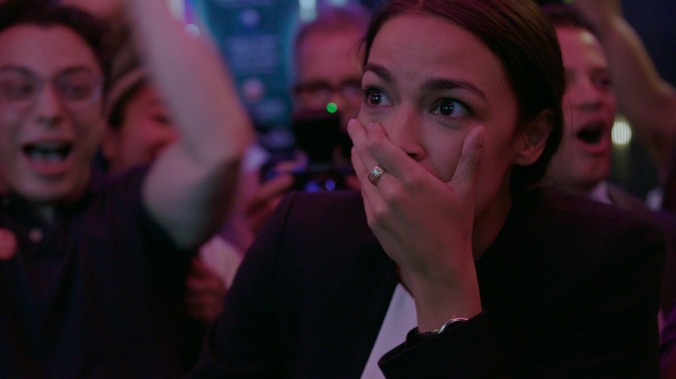There’s an interesting debate to be had about whether political art requires an audience to agree with its partisan point of view ahead of time in order to be successful. No such concerns need intrude on the enjoyment of Netflix’s Knock Down The House, largely because—despite focusing on progressive campaigns against establishment politicians from overtly leftist challengers—actual policy takes a backseat to the scrappy underdog stories the film highlights. There’s a timeless appeal to watching David take down Goliath with little more than a slingshot, and in lucking into an intimate look at the insurgent campaign of Alexandria Ocasio-Cortez, the makers of this documentary stumbled upon one hell of a David.
Indeed, the tone of this fairly conventional doc would likely have been much more dispiriting without its breakout star and newly minted member of the U.S. House of Representatives. Anyone who pays much attention to American electoral politics will already know the outcome of the three other candidates followed by director Rachel Lears’ camera—Amy Vilela in Las Vegas, St. Louis’ Cori Bush, and Paula Jean Swearengin in Coal City, West Virgina—and it would’ve been tough to wring the film’s celebratory tone out of a four-for-four account of loss. Fortunately for Lears, who based her project on observing the plucky campaigns of the four candidates recruited by Justice Democrats and Brand New Congress, a pair of electoral activist non-profits dedicated to getting working-class people elected to Congress and thereby weaken the stranglehold of large corporate interests on the democratic process, that didn’t happen.
As a result, the film’s throughline is AOC, whom we follow as she travels to Frankfort, Kentucky to accept the group’s recruitment to run in 2018 against longtime incumbent and fourth-most-senior Democrat in the house, Joe Crowley. (In a nice bit of backstory, we learn she was brought to Justice Democrats’ attention by her brother, who submitted her name as someone he simply thought would make a fine member of Congress.) Starting a year before the election, we watch as she learns how to knock on doors, meet with charismatic local community organizers and Democratic activists, debate campaign strategy, score victories in the lead-up to the election by upstaging Crowley when he no-shows at a town hall, and generally learn on the fly how to be a candidate. It’s awfully close to hagiography, but it also demonstrates why AOC is such a good campaigner: She’s incredibly appealing and charismatic, quick-witted and telegenic in equal measure—the ideal subject of a documentary, in other words. The word “relatable” is overused in conjunction with politicians, but when watching her react to the proposal of slapping “Abolish ICE” on a campaign poster with an excited, “That’s straight gangster,” it’s impossible to deny.
The other candidates are quite compelling as well, playing supporting roles only by dint of how their respective elections turned out. Swearengin has the most evocative story, her frustration over the environmental devastation and health crises triggered by the coal industry’s effect on her hometown visually depicted in heartbreaking vistas of leveled mountains, stark imagery that overshadows the other narratives. Vilela comes across like a resourceful mom, literally picking up after her twentysomething staffers in their cramped office. Her backstory is tragic—her focus on healthcare is motivated by the death of her 22-year-old daughter in 2015, after being turned away from an emergency room for being uninsured—so watching her and her team crying in the aftermath of their loss lends a poignant counterpoint to the ebullient catharsis of the AOC story. And Bush, who arguably gets the least screen time, is shown dealing with the frank realities of running against a candidate who isn’t just part of an institution (her opponent, Lacy Clay, holds the same seat previously held by his father), but a pillar of a black community in Atlanta predisposed to continue supporting one of their own, corporate interests or no.
But Lears and editor Robin Blotnick have smartly structured their film, because the momentum of Ocasio-Cortez’s campaign is infectious. It’s easy to see why the film took home the Audience Award for Festival Favorite at Sundance this year; each step of the electoral process is depicted so as to build empathy for AOC in her uphill battle, making the eventual footage of her watching in shocked disbelief as the TV news reports her win all the more potent.
It’s not hard to be outraged by the need for her team to collect five times the required number of signatures to get her on the ballot, thanks to Crowley’s control of the local party machinery that will work overtime to throw out every possible signature that so much as fails to dot an I. And the demeaning and disheartening process of fundraising is shown to be exactly the millstone around the neck of the democratic process that Justice Democrats claim it is, with Vilela making desperate phone calls to supporters, trying to wring out 50 more bucks at a time. But it’d be tough to dream up a better feel-good ending for a movie about the long odds of taking on the powerfully entrenched incumbent recipients of corporate largesse than Ocasio-Cortez’s against-all-odds tale; the inevitable dramatized version is going to have one hell of a time seeming plausible.


